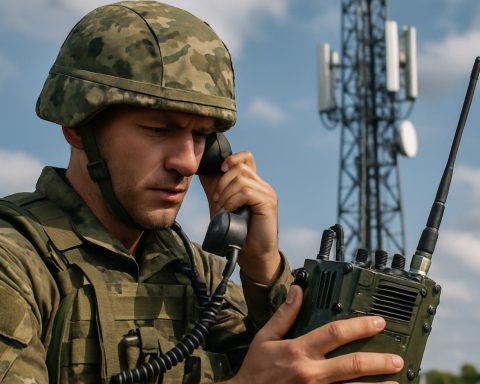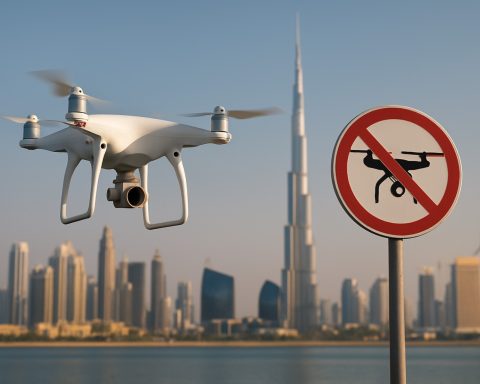Transforming the Battlefield: How Military Radio and Telecommunications Evolved from Field Phones to 5G Connectivity
- Current Landscape of Military Radio and Telecommunications
- Emerging Technologies Shaping Defense Communications
- Key Players and Strategic Dynamics in Military Telecom
- Projected Expansion and Investment in Military Communications
- Geographic Trends and Regional Market Insights
- Next-Generation Capabilities and Strategic Directions
- Barriers, Risks, and Growth Opportunities in Military Telecom
- Sources & References
“Overview of Drone Laws in India (2025) India has established a comprehensive regulatory framework for civilian drone operations as of 2025.” (source)
Current Landscape of Military Radio and Telecommunications
The evolution of military radio and telecommunications has been marked by rapid technological advancements, transforming how armed forces communicate, coordinate, and operate. From the rudimentary field phones of the early 20th century to the integration of 5G networks, the landscape has shifted dramatically to meet the demands of modern warfare.
Early Innovations: Field Phones and Analog Radios
- During World War I and II, field telephones and analog radios were the backbone of military communications, enabling real-time voice transmission over wired and wireless networks. These systems, while revolutionary for their time, were limited by range, susceptibility to interception, and the need for physical infrastructure (U.S. Army).
Cold War Era: Secure and Mobile Communications
- The Cold War period saw the introduction of frequency-hopping radios and encrypted communication systems, such as the SINCGARS (Single Channel Ground and Airborne Radio System), which improved security and mobility for troops (Army Technology).
Digital Transformation: Satellite and Software-Defined Radios
- The late 20th and early 21st centuries brought digitalization, with satellite communications (SATCOM) enabling global connectivity and real-time data sharing. Software-defined radios (SDRs) further enhanced flexibility, allowing devices to switch frequencies and protocols dynamically (NATO Review).
Modern Era: 5G and Network-Centric Warfare
- Today, the adoption of 5G technology is revolutionizing military telecommunications. 5G offers ultra-low latency, high bandwidth, and the ability to connect massive numbers of devices, supporting applications like autonomous vehicles, real-time intelligence sharing, and augmented reality for soldiers (Defense News).
- According to a 2023 report, the global military communications market is projected to reach $40.6 billion by 2028, driven by investments in secure, resilient, and high-speed networks (MarketsandMarkets).
In summary, military radio and telecommunications have evolved from basic voice transmission tools to sophisticated, secure, and high-speed networks. This evolution underpins the effectiveness of modern military operations, enabling seamless coordination and rapid response in increasingly complex environments.
Emerging Technologies Shaping Defense Communications
The evolution of military radio and telecommunications has been marked by rapid technological advancements, transforming how armed forces communicate on and off the battlefield. Early military communications relied on field telephones and wired telegraphy, which, while reliable, were limited by their dependence on physical infrastructure. The introduction of radio in the early 20th century revolutionized military operations, enabling wireless communication over vast distances and in challenging environments (U.S. Army).
During World War II, portable radios such as the SCR-300 “walkie-talkie” became standard issue, providing greater mobility and coordination for troops. The Cold War era saw the development of more secure and robust systems, including frequency-hopping radios to counteract jamming and interception (National WWII Museum).
In recent decades, digitalization has driven a new wave of innovation. Software-defined radios (SDRs) allow for real-time reconfiguration, supporting multiple communication standards and encryption protocols on a single device. This flexibility is crucial for interoperability among allied forces and adapting to rapidly changing operational requirements (NATO).
The advent of 5G technology is poised to further transform military communications. 5G offers ultra-low latency, high bandwidth, and the ability to connect massive numbers of devices simultaneously. These features enable real-time data sharing, support for autonomous vehicles, and enhanced situational awareness through the integration of sensors and Internet of Things (IoT) devices (Defense News). The U.S. Department of Defense has invested over $600 million in 5G testbeds to explore applications ranging from smart warehouses to augmented reality training (CTIA).
- Field Phones: Reliable but limited by physical connections.
- Analog Radios: Enabled wireless, mobile communication.
- Digital & SDRs: Enhanced security, flexibility, and interoperability.
- 5G Networks: High-speed, low-latency, and massive device connectivity for next-gen operations.
As military operations become more complex and data-driven, the integration of emerging technologies like 5G, AI, and IoT will continue to shape the future of defense communications, ensuring secure, resilient, and adaptive networks for modern warfare.
Key Players and Strategic Dynamics in Military Telecom
The evolution of military radio and telecommunications has been marked by rapid technological advancements, shifting from rudimentary field phones to sophisticated 5G-enabled networks. Early military communications relied on wired field telephones and Morse code, which, while revolutionary for their time, were limited by range and vulnerability to interception. The introduction of radio during World War I and II dramatically expanded operational flexibility, enabling real-time, wireless communication across battlefields (Army Technology).
By the late 20th century, the adoption of secure, frequency-hopping radios such as the SINCGARS (Single Channel Ground and Airborne Radio System) improved resistance to jamming and eavesdropping. The digital revolution further transformed military telecom, with satellite communications (SATCOM) providing global reach and the ability to coordinate complex, multi-domain operations. The U.S. Department of Defense, for example, invested heavily in the Mobile User Objective System (MUOS), a next-generation narrowband SATCOM network that supports secure voice and data communications worldwide (Lockheed Martin).
Today, the integration of 5G technology is poised to redefine military communications. 5G offers ultra-low latency, high bandwidth, and the capacity to connect massive numbers of devices, supporting applications from autonomous vehicles to real-time intelligence sharing. The U.S. Department of Defense has launched several 5G pilot projects at military bases, focusing on smart warehouses, augmented reality for training, and secure tactical networks (U.S. Department of Defense).
- Key Players: Major defense contractors such as Lockheed Martin, Raytheon Technologies, Northrop Grumman, and Thales Group are at the forefront, developing secure, resilient communication systems.
- Strategic Dynamics: The race for technological superiority is intensifying, with NATO and allied nations investing in interoperable, cyber-resilient networks, while adversaries like China and Russia pursue electronic warfare and anti-satellite capabilities (NATO).
In summary, military telecommunications have evolved from basic field phones to complex, multi-layered networks leveraging 5G and beyond, with key players and strategic priorities shaped by the demands of modern, information-centric warfare.
Projected Expansion and Investment in Military Communications
The evolution of military radio and telecommunications has been marked by rapid technological advancements, shifting from rudimentary field phones to sophisticated 5G-enabled networks. This transformation is not only enhancing battlefield communication but also driving significant projected expansion and investment in the sector.
Historically, military communications relied on wired field telephones and analog radios, which, while reliable, were limited in range and susceptible to interception. The introduction of frequency-hopping radios in the late 20th century improved security and flexibility, but the real leap has come with the integration of digital and wireless technologies. Today, militaries are increasingly adopting software-defined radios (SDRs), satellite communications, and mobile ad hoc networks (MANETs) to ensure secure, resilient, and high-speed data transmission across diverse operational environments (Army Technology).
The global military communications market is experiencing robust growth, driven by the need for real-time data sharing, interoperability, and cyber resilience. According to a recent report, the market is projected to grow from $37.2 billion in 2023 to $46.4 billion by 2028, at a compound annual growth rate (CAGR) of 4.5% (MarketsandMarkets). Key investment areas include:
- 5G Integration: The adoption of 5G technology is set to revolutionize military communications by enabling ultra-low latency, high bandwidth, and seamless connectivity for autonomous vehicles, drones, and command centers (Defense News).
- Satellite Communications: Investments in next-generation satellite systems are ensuring global coverage and redundancy, critical for operations in remote or contested environments (Space.com).
- Cybersecurity: As digital networks proliferate, securing communications against cyber threats is a top priority, prompting increased spending on encryption and network defense technologies.
Major defense contractors and technology firms are actively partnering with governments to develop and deploy these advanced systems. The U.S. Department of Defense, for example, has launched multiple initiatives to test and implement 5G networks on military bases and in field operations (U.S. Department of Defense).
In summary, the shift from field phones to 5G represents a paradigm change in military communications, with substantial investments fueling innovation and expansion to meet the demands of modern warfare.
Geographic Trends and Regional Market Insights
The evolution of military radio and telecommunications has been profoundly shaped by geographic trends and regional market dynamics. From the early adoption of field phones in World War I to the current deployment of 5G-enabled systems, different regions have advanced at varying paces, influenced by strategic priorities, technological capabilities, and security concerns.
North America remains at the forefront of military communications innovation. The United States, in particular, has consistently invested in upgrading its tactical communication infrastructure, with the Department of Defense (DoD) allocating over $12 billion for communications, command, and control systems in its 2024 budget (U.S. Department of Defense). The region is rapidly integrating 5G technologies to enable secure, high-speed data transfer and support for autonomous systems, with pilot projects underway at several military bases (C4ISRNET).
Europe is modernizing its military communications in response to heightened security threats and NATO interoperability requirements. The European Defence Agency (EDA) has launched initiatives to standardize secure radio communications across member states, with a focus on Software Defined Radios (SDR) and encrypted mobile networks (European Defence Agency). The ongoing conflict in Ukraine has accelerated investments in resilient, jam-resistant communication systems, with countries like Germany and France increasing their defense budgets for digital modernization.
Asia-Pacific is witnessing rapid growth, driven by regional tensions and technological advancements. China is developing indigenous 5G military networks and quantum communication systems, aiming for secure, real-time battlefield connectivity (South China Morning Post). India and Japan are also investing in next-generation tactical radios and satellite communications to enhance situational awareness and command capabilities.
Middle East & Africa are gradually upgrading legacy systems, often with support from Western defense contractors. The focus is on mobile, encrypted radios and satellite-based solutions to address vast, challenging terrains and asymmetric threats (Army Technology).
Overall, the global military radio and telecommunications market is projected to reach $40.6 billion by 2028, with 5G and secure, software-defined solutions driving regional investments and shaping the future battlefield (MarketsandMarkets).
Next-Generation Capabilities and Strategic Directions
The evolution of military radio and telecommunications has been marked by rapid technological advancements, transforming battlefield communications from rudimentary field phones to sophisticated 5G-enabled networks. Early military communications relied on wired field telephones, which, while reliable, were limited by their dependence on physical infrastructure and vulnerability to interception and sabotage. The introduction of wireless radio during World War I revolutionized command and control, enabling real-time communication across dispersed units (U.S. Army).
World War II saw further advancements with the deployment of portable radios like the SCR-300, which allowed for greater mobility and coordination. The Cold War era introduced frequency-hopping and encrypted radios, significantly enhancing security and resistance to jamming. The 1980s and 1990s brought digital communications, satellite links, and the integration of data transmission, laying the groundwork for network-centric warfare (National Defense Magazine).
Today, the military is embracing next-generation capabilities, with 5G technology at the forefront. 5G offers ultra-low latency, high bandwidth, and the ability to connect massive numbers of devices, supporting applications such as autonomous vehicles, real-time sensor fusion, and augmented reality for soldiers. The U.S. Department of Defense has invested over $600 million in 5G testbeds at military bases, exploring use cases like smart warehouses, dynamic spectrum sharing, and secure tactical communications (U.S. Department of Defense).
- Interoperability: Modern systems are designed for seamless integration across allied forces, enhancing coalition operations.
- Cybersecurity: As networks become more complex, protecting communications from cyber threats is a top priority.
- Resilience: Mesh networking and software-defined radios ensure communications remain operational in contested environments.
- AI Integration: Artificial intelligence is being leveraged for spectrum management, threat detection, and autonomous decision-making.
Looking ahead, the strategic direction of military telecommunications is focused on leveraging commercial innovations, ensuring secure and resilient networks, and enabling multi-domain operations. The shift from field phones to 5G exemplifies the military’s commitment to maintaining information superiority in an increasingly contested and technologically advanced battlespace (RAND Corporation).
Barriers, Risks, and Growth Opportunities in Military Telecom
The evolution of military radio and telecommunications has been marked by rapid technological advancements, shifting operational requirements, and the constant need to outpace adversaries. From the rudimentary field phones of World War I to the integration of 5G networks, each era has introduced new capabilities, but also new barriers and risks, while opening up significant growth opportunities.
- Barriers: Historically, the adoption of new telecom technologies in the military has been hampered by interoperability challenges, legacy system integration, and stringent security requirements. For example, transitioning from analog to digital radios required extensive retraining and infrastructure overhaul. Today, the integration of 5G faces hurdles such as spectrum allocation conflicts, supply chain security concerns, and the need for robust encryption to prevent cyber espionage (RAND Corporation).
- Risks: As military communications become more sophisticated, so do the associated risks. Cyber threats are a primary concern, with adversaries targeting vulnerabilities in both hardware and software. The proliferation of software-defined radios (SDRs) and networked communications increases the attack surface for jamming, interception, and data manipulation. The U.S. Department of Defense has highlighted the risk of supply chain infiltration, particularly with the global expansion of 5G infrastructure (U.S. Department of Defense).
- Growth Opportunities: Despite these challenges, the military telecom sector is poised for significant growth. The global military communications market is projected to reach $40.6 billion by 2027, driven by investments in secure mobile networks, satellite communications, and AI-enabled systems (MarketsandMarkets). The adoption of 5G promises ultra-low latency, enhanced bandwidth, and the ability to connect a vast array of sensors and autonomous platforms, enabling real-time situational awareness and faster decision-making. Additionally, partnerships with commercial telecom providers are accelerating the deployment of dual-use technologies, further expanding the market landscape.
In summary, the journey from field phones to 5G encapsulates a century of innovation, with each leap forward presenting new barriers and risks, but also unlocking transformative growth opportunities for military communications worldwide.
Sources & References
- From Field Phones to 5G: The Evolution of Military Radio and Telecommunications
- U.S. Army
- Army Technology
- Defense News
- MarketsandMarkets
- National WWII Museum
- Lockheed Martin
- Raytheon Technologies
- Northrop Grumman
- Thales Group
- Space.com
- C4ISRNET
- South China Morning Post
- National Defense Magazine









